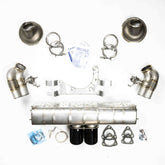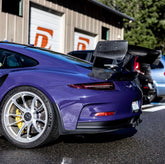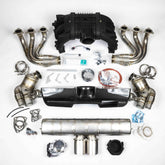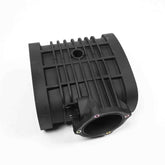Extended Length Tie Rod End Set. Porsche GT Titanium Upgrade
Porsche has long been a leader in high-performance sports cars, with its GT models standing out as some of the best-handling machines on the road and track. One crucial component of these cars' steering systems is the tie rod end. In this article, we will explore the role of extended-length titanium tie rod ends, why they are necessary, and how they improve performance and safety.
For a detailed explanation, you can also watch the full video here: Porsche Extended Length Titanium Tie Rod End Set.
What Are Tie Rod Ends?
Tie rod ends are an integral part of a car’s steering system. They connect the steering rack to the knuckle, which is the component that holds the wheel. When the steering wheel is turned, the tie rods transmit force from the steering rack to the wheels, allowing the car to change direction.
Extended tie rod ends are especially important for Porsche GT models where negative camber is increased, as they ensure the safety and reliability of the steering system under high-performance conditions.
Extended Length Titanium Tie Rod End product page.
The Importance of Extended-Length Tie Rod Ends
For performance-oriented Porsche models such as the 991 GT3, 981 GT4, 718 GT4, and 992 GT3, negative camber is often increased to enhance handling. Negative camber improves cornering grip by ensuring that more of the tire's contact patch remains engaged with the road during aggressive turns.
However, increasing negative camber moves the wheels further apart, extending the distance between the steering rack and the knuckle. Standard tie rod ends may not have sufficient thread engagement at these increased distances, leading to a potential safety hazard. Some drivers may try to compensate by tightening the nut with only a few threads of engagement, but this is highly unsafe. The extended-length titanium tie rod ends provide a solution by ensuring full thread engagement, eliminating this risk.
Advantages of Titanium Construction
Titanium is a preferred material in high-performance automotive applications for several reasons:
Strength-to-Weight Ratio: Titanium provides a superior strength-to-weight ratio compared to steel and aluminum, making it ideal for high-stress components like tie rod ends.
Durability: Titanium is corrosion-resistant, ensuring longevity even in harsh driving conditions.
Minimal Cost Difference: Compared to aluminum, titanium offers significant benefits with only a marginal cost increase.
When developing these tie rod ends, the cost difference between using aluminum and titanium was surprisingly small, making titanium the obvious choice. The material also enhances the overall aesthetic appeal of performance modifications.
Impact on Steering Feel and Alignment
One of the most common questions about extended-length tie rod ends is how they affect steering feel. In reality, the extended length itself does not significantly alter feedback through the steering wheel. However, it plays a crucial role in allowing for safe suspension modifications.
Increasing negative camber without extended tie rod ends can lead to dangerous driving conditions where only a few threads hold the tie rod in place. This makes the car unstable and risky to drive on the track or road. By using extended tie rods, drivers can safely dial in more aggressive camber settings while maintaining proper toe adjustment.
Additionally, these upgraded tie rods allow more range for toe adjustment. Instead of being limited to the stock tie rod's short threading, extended-length options give flexibility to set the desired toe angle without compromising safety.
Installation and Maintenance
Installation of extended-length tie rod ends does not require any special tools beyond those typically used in suspension work. However, because suspension parts are under load and can be heavy, it is advisable to have an experienced mechanic perform the installation. If you are a confident DIY mechanic, installation is feasible with the right approach.
Furthermore, these tie rods do not require any special maintenance beyond regular inspections, similar to other suspension components. The wear component in these tie rods is the FK stainless Teflon-coated ball joint, which is the highest-grade part available for such applications. This ensures long-lasting performance and reliability.
Expected Durability and Warranty Considerations
While titanium tie rod ends are expected to last as long as stock components, their durability depends on usage conditions. If the car is frequently driven in harsh environments such as areas with road salt, off-road conditions, or excessive dirt and debris, wear may occur faster than in standard street use. However, for most Porsche owners who drive their cars on weekends, on mountain roads, or at occasional track days, these components should last a long time without issue.
Regarding warranties, because these are aftermarket parts, Porsche dealerships may not cover them under standard vehicle warranties. However, since these tie rods are a direct replacement rather than a fundamental suspension alteration, they are unlikely to cause any warranty issues. If a problem arises, it is advisable to contact the manufacturer first rather than relying on a dealer for repairs.
Conclusion
Extended-length titanium tie rod ends are an essential upgrade for Porsche GT models that undergo aggressive suspension modifications. They provide safety, improved adjustability, and durability while ensuring that extreme negative camber settings do not compromise the integrity of the steering system. With their enhanced material properties and minimal impact on cost, titanium tie rod ends represent an intelligent investment for enthusiasts who demand the best performance from their vehicles.






